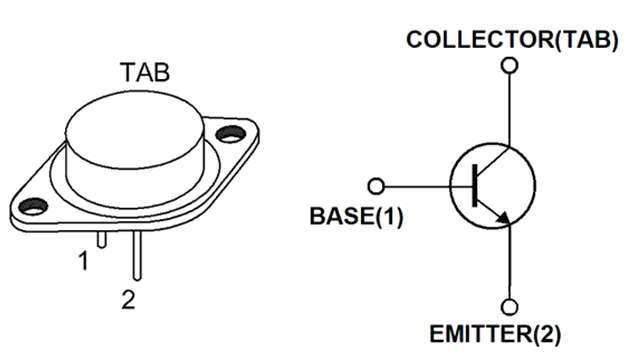- 2N3055 is a general-purpose NPN power transistor manufactured with the epitaxial base process, mounted in a hermetically sealed metal case. The device is designed for general purpose switching and amplifier applications.

- 2N3055 is preferred when you want a simple switching device for medium power loads. 2N3055 is one of the basic transistors available in the market for cheap and with features being suited for many applications.
- 2N3055 is also used in audio power amplifiers. The device has a good amplifying factor and also the gain is almost linear making 2N3055 one of the best solutions for power amplifiers.
- It is one of the oldest transistors that is still used in many projects. 2N3055 transistor comes in TO-3 case and has maximum absolute Collector Current(continuous), Collector to Base voltage, and Power dissipation rating of 15 A, 100 V, and 115 W respectively. The maximum current gain is 120.
Pin Configuration
- Pin 1: Base ( B ) Normally used as a trigger to turn ON the transistor.
- Pin 2: Emitter ( E ) normally connected to GROUND.
- TAB or CASE: Collector ( C ) Normally connected to LOAD.

Specifications/Features
- Collector-Base Voltage ( VCBO ) 100 V.
- Collector-Emitter Voltage ( VCEO ) 60 V.
- Emitter-Base Voltage ( VEBO ) 7 V.
- Continuous Collector Current( IC ) 15 A.
- Continuous Base Current ( IB ) 7 A.
- DC Current Gain ( hFE ) 120 ( Max ).
- Collector Power Dissipation ( PC ) 115 W.
- Storage Temperature ( TSTG ) -65 °C ~ 200 °C.
How to use the 2N3055 Transistor
- Let us consider a simple application circuit as shown below.
- Here we are going to use 2N3055 as a simple switching device to drive a motor and is in a common emitter configuration.
![]()
- As shown in the circuit we are using a motor as the load and the gate signal for turning ON the transistor is provided by a 5V source with a button being the triggering device. The trigger source and power source must share a common ground for the circuit to work. The 100Ω resistor is provided for limiting the current through the base.
- Under initial conditions, the button will be open and no current flows through the base of the transistor. With no base current, the transistor acts as an open circuit and the entire supply voltage V1 will appear across it.
- When the button is pressed at a certain time, the voltage V2 forms a closed loop with the base-emitter of the transistor as can be seen in the circuit diagram. With this closed loop, a current flows through the base of the transistor, and with the base current flow, the transistor gets turned ON. Having the transistor acting as a short circuit in the ON state there will be a collector current that flows through the motor making it rotate. This motor will keep rotating until there will be base current.
- After a certain time when the button is released the base current becomes zero and the transistor gets turned OFF. With the transistor going to a high resistance state in OFF mode, the collector current also becomes zero bringing the motor to stop.
Application of 2N3055 Transistor
- As a switching transistor in medium power applications.
- Used in some old television models.
- Audio power amplifiers. Typically configured in a push-pull configuration delivering up to 40 Watts into an 8 a speaker(load).
- Sometimes used in regulator circuits.
- Series pass transistor in linear power supplies.
- Signal Amplifiers.
